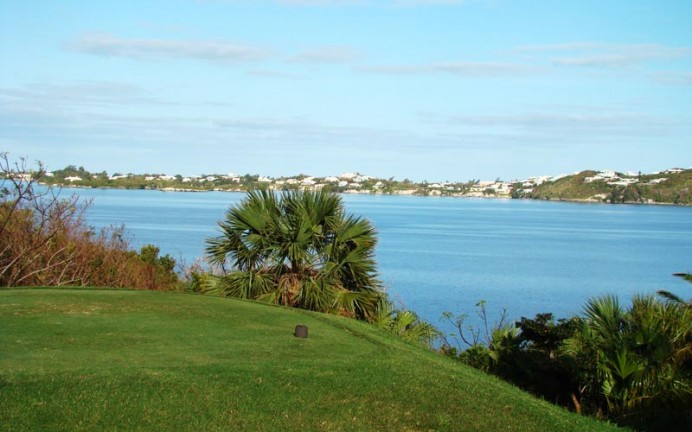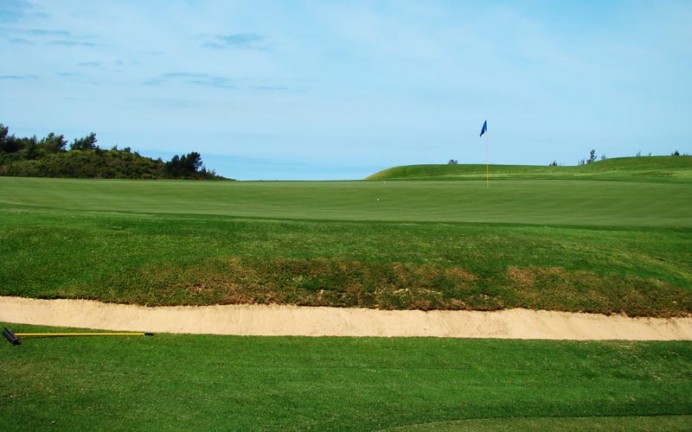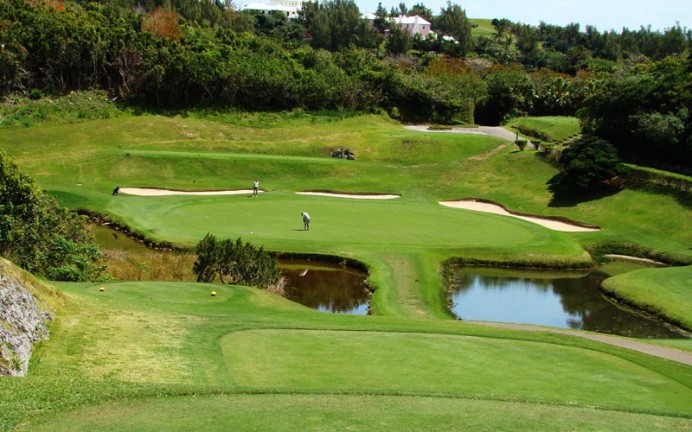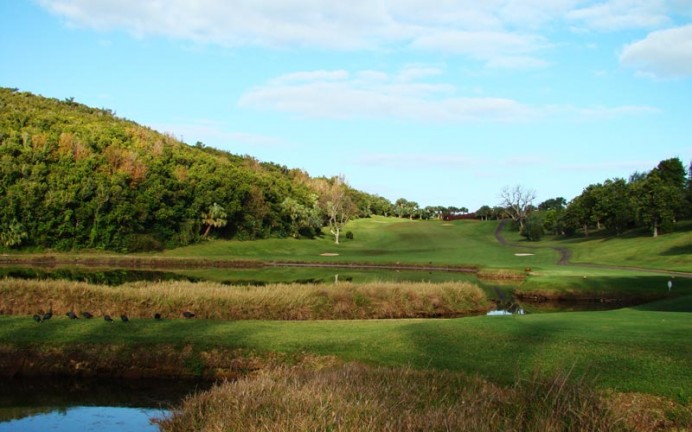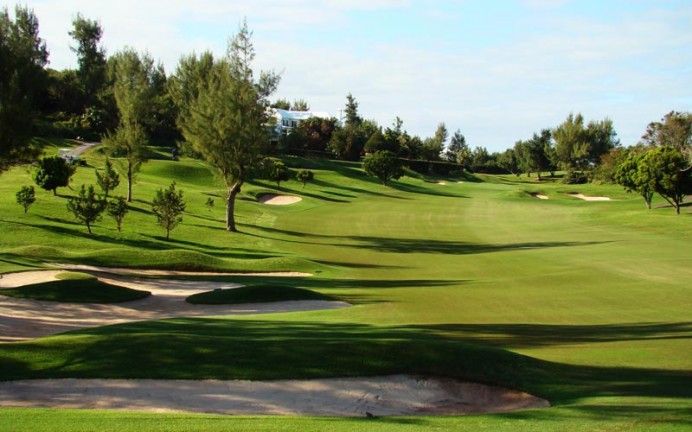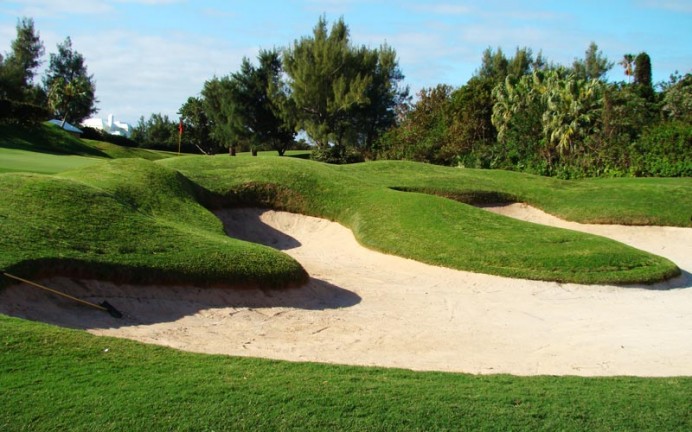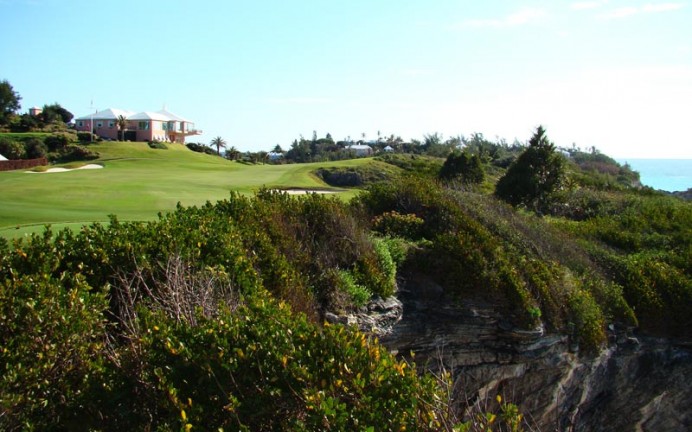Mid Ocean Club
Tucker Town, Bermuda
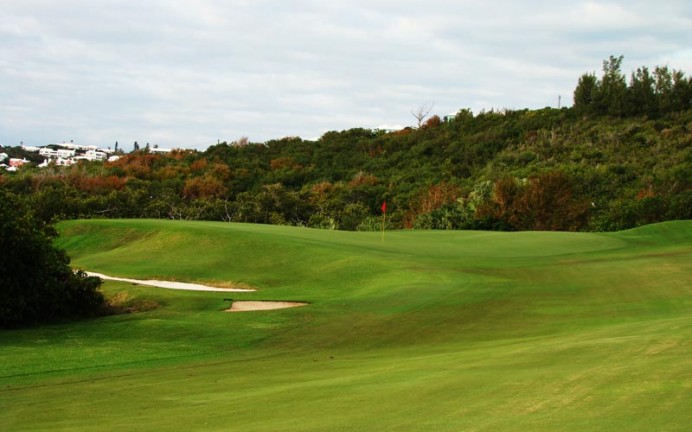
Macdonald’s bold architecture proved the perfect compliment to the rugged cliffs and rolling topography of Tuckers Town on the island of Bermuda.
Completed in 1921 by Charles Blair Macdonald‘s Mid Ocean Golf Club set a standard for small island golf that many feel has yet to be matched. Some modern courses like Pete Dye’s Casa de Campo in the Dominican Republic or Greg Norman/Bob Harrison’s design of Nirwana Bali in Indonesia enjoy more holes with spectacular ocean frontage, yet the cumulative sequence of holes at Mid Ocean Golf Club, and the variety of challenge that they possess, still make it the island course by which all are judged.
The opportunity to develop a course here was presented to Macdonald by the Furness Withy Steamship Company who hoped to develop Bermuda as a tourist destination. Some of Macdonald‘s Long Island friends considered Cuba to be the better place to spend the long cold New York winters but Macdonald, as he writes in Scotland’s Gift in 1928, ‘…felt confident Bermuda was the place.’
After scouring the island, Macdonald finally settled on an area known as Tuckers Town. Though the process of acquiring the land was more laborious and expensive than hoped, they eventually secured 600 acres. The southern part of the property ran for approximately 1,500 yards along the cliffs by the azure Atlantic Ocean and was bordered to the northwest by Harrington Sound and to the northeast by Castle Harbour. Two natural lakes were found within the acres, one being Mangrove Lake and the other Trott’s Pond.
Macdonald‘s first task was to route the course in such a manner that the visiting golfer was glad he made the trip to this island destination. In the day, the journey was by boat as opposed to plane and thus, being more time consuming, it was particularly important that the course get off to a quick start. Of the first four holes, two of the green sites (e.g. the first and third) are hard by the cliffs as are two of the tees (e.g. the second and fourth). The famous fifth drops the golfer from high above Mangrove Lake to along its shore while the sixth takes maximum advantage of the site’s rolling topography. From here until the uphill sixteenth, the game is played mostly through valleys. This is for good reason as we see when Charles Blair Macdonald wrote in Scotland’s Gift, ‘It was only within the valleys that there was any soil. In these valleys the principal products were onions, potatoes, and Easter lilies. Below the six inches of soil was coral rock. We pursued the same course making contour and relief maps as we had in building other courses.’
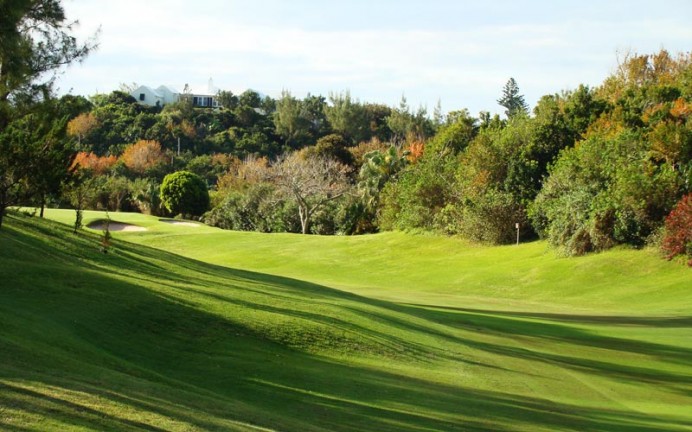
Macdonald elected to route many of the holes through valleys as that was where the only soil was found. The eleventh fairway as seen above is one such example. Otherwise, as seen behind the… …thirteenth tee, coral rock was frequently just under the surface. Be it at Lido or Yale or here, Macdonald’s construction supervisor Seth Raynor was a master at building courses that looked natural despite difficult circumstances.
Macdonald was enamored with the topography of the inland holes. Again, he writes, ‘The contours of the property are unsurpassed, delightful valleys, one to two hundred yards in width, winding through coral hills from twenty to seventy-five feet in height, along the line of play; well wooded with cedars, oleanders, bougainvilleas and hibiscus, lending the most fascinating color scheme to the whole.’ After the one shot seventh, the eighth and ninth play through their own valleys, as do the eleventh and twelfth. A nearly two hundred yard wide valley is found at the fourteenth and fifteenth where Macdonald routed the two holes parallel to one another. From here, Macdonald took the golfer up and over the side of the valley at the sixteenth before the rousing cliff side finish.
With the routing complete, the chore of building the course began. Fortunately, Macdonald brought his ‘A’ team to the project, meaning Seth Raynor, Charles Banks, and Ralph Barton. These men were the most able to translate Macdonald‘s design ideas into reality.
Completed on December 15th, 1921, the course possessed a great number of Macdonald’s prototypical favorite strategic holes as seen below.
Holes to Note
First hole, 420 yards, Atlantic; Featuring twenty-two bunkers (!), the first is easily the most heavily bunkered hole on the course. However, what gives the hole its teeth is that the green is both the highest and most exposed point on the course. All kinds of things can happen here, as Angel Cabrera can attest having carded an ‘eight’ here during the 2007 PGA Grand Slam. When the conversation turns to the world’s best opening hole, this one stands in equal company to the first at Pine Valley, Hoylake, and Machrihanish. In common with those holes, it makes for a superb nineteenth or play-off hole.
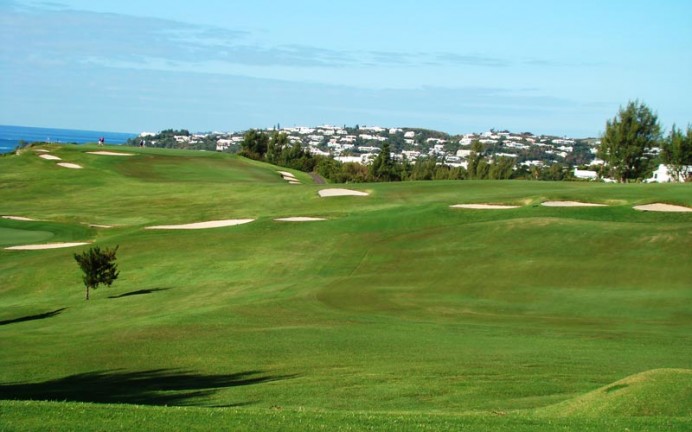
The first doglegs to the left and plays from hilltop to hilltop. A good line off the tee is over the center of the three bunkers seen above right.
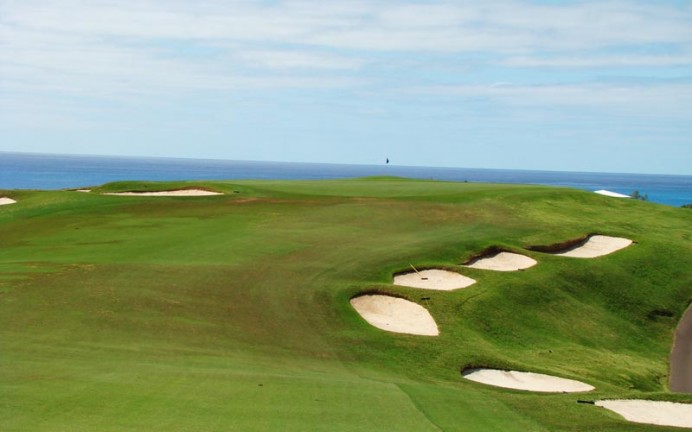
As the high point of its surrounds, the putting surface does nothing to help or gather balls toward it; indeed just the opposite.
Second hole, 470 yards, Long; Within the family of Macdonald‘s favorite holes, the weakest adaptation for some strange reason is his version of the Long hole. There is no clear reason why he consistently failed in building three shotters that were even remotely as compelling as the fourteenth at St. Andrews. After all, his Redan and Leven at National Golf Links of America are considered superior to their originals. Again here at Mid Ocean, the Long hole lacks the equivalent of a Hell Bunker to lend the second shot its interest. Thanks to an intelligent tree clearing program in the past six years, the hole does offer optional routes off the tee with the chance to skirt past the inside bunker on this dogleg left being particularly alluring. For the second time in as many holes, the golfer faces an approach to an elevated green. On the front nine, elevated greens at the first, second, fourth, sixth, eighth, and ninth holes make the front play significantly longer than its modest length of 3,125 yards suggests.
Third hole, 190 yards, Eden; The quintessential Eden features are all present: the Hill bunker left and Strath bunker right guard this sharply sloped back to front green. In addition, the green is much wider than it is deep, so even on the rare calm day, it represents a shallow target. Importantly, though, calm days are the exception rather than the rule. Having learned the game in Scotland, Macdonald considered wind as being absolutely crucial to good golf and Mid Ocean possesses that hidden element in spades. In studying his work, the joy comes in seeing how he adopted his favorite holes/design strategies to each of the different sites with which he had to work. Here, he placed his Eden cliff side with the prevailing wind blowing left to right and into the golfer. The close proximity to the cliffs makes left hole locations among the scariest on the course. Indeed, during the PGA Grand Slam, the four professionals were content to hit for the middle right of this green as opposed toward the day’s left hole location. It is worth noting that Macdonald played golf with Davey Strath (for whom the bunker at the Eden at St. Andrews is named) while attending St. Andrews University in 1872 and 1873.
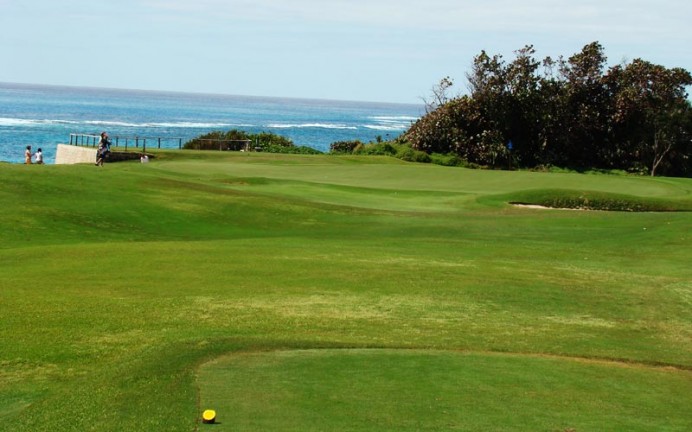
Today’s right hole location (the blue flag is seen against the bushes) is easier than when the hole is left with only the ocean as the backdrop to the fluttering flag.
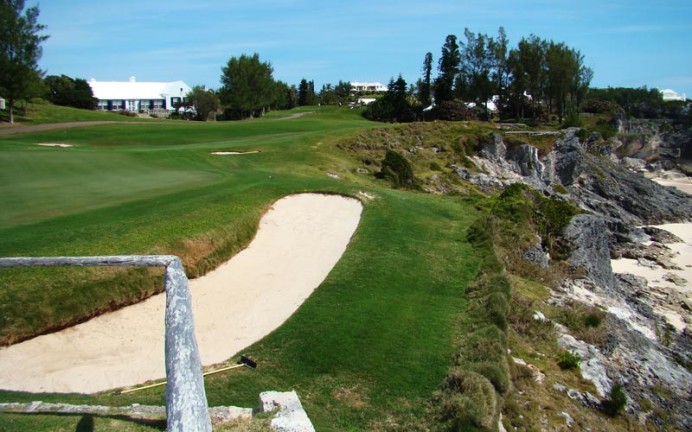
This view from the fourth tee looking back down the Eden shows the peril that awaits a tee ball that drifts left. The white house in the background served as the clubhouse for the first few years, meaning that until the first clubhouse proper was built, play commenced here on this par three.
Fourth hole, 330 yards, Mangrove; When routing the course, Macdonald, one imagines, must have taken great delight in finding a cliff setting for his beloved Eden hole. Furthermore, one assumes that Charles Blair Macdonald early in the routing process discovered the commanding tee position high above Mangrove Lake for what is today’s fifth hole. Thus, the question became how to get from one hole to the other. Indeed, the merit of such a connector hole (i.e. a hole that connects one great hole to another) has a great say in how well a course well be perceived over time. Just a few mediocre holes and the overall merit of any course is tarnished. In this case, Macdonald came up with a beauty of a short par four. A thorough original, this hole has two qualities that have proven particularly irksome. The first is that drives that finish from 120 to 90 yards (i.e. just where the golfer hopes to drive it) from the green leave a blind approach, given the abrupt slope of the hill upon which the green sits. Only from spots either further back or closer is the flag visible. The second playing characteristic that torments golfers is the green’s wicked back to front slope, featuring nearly a five foot drop. The uniqueness of this short two shotter, and its stubbornness to yield birdies, has earned it many admirers over the decades.
Fifth hole, 435 yards; Cape; Despite being one of the most photographed, written about, and copied holes in world golf, the sensation of standing on the tee and preparing to hit never fails to thrill. From ninety feet above Mangrove Lake, the golfer debates how much to cut off with his tee ball given the day’s playing conditions (the prevailing wind is behind the golfer, quartering from left to right). Because the view from the tee is so mesmerizing, the strategic merit of the hole is often overlooked. Not unlike the thirteenth at Augusta National, the closer one’s tee ball finishes to the hazard, the more level the stance and the better the angle one has into the green. In the case of Mid Ocean, Macdonald‘s stunning green complex accepts approach shots played from the left center of the fairway. The further one steers away from Mangrove Lake off the tee, the worse one’s approach angle into the green, thanks to both the fairway’s and green’s pronounced right to left tilt. Entirely manufactured, the green complex is the boldest on the course. Macdonald‘s twenty courses that he designed, which is quite a small number relative to the body of work of many successful modern architects, yielded an amazingly high percentage of world class holes. Yet, who could fault anyone for selecting the fifth as perhaps Macdonald‘s best? In many ways, it captures his colossal personality as well as his design talent/flair for producing holes of lasting strategic merit that were fun to play. George Bahto, leading Macdonald historian and author of The Evangelist of Golf, notes, ‘ His use of important design characteristics of the great holes from Europe melded into his innate ability to recreate them in a bold manner that set him apart from his protégés. Many of his favorite theme holes at National Golf Links of America were never surpassed including the Short, Redan and Alps. However, there is one important exception that comes to mind and that is the Cape hole at Mid Ocean; truly an enigmatic and brilliant golf hole not forced into the local terrain.’
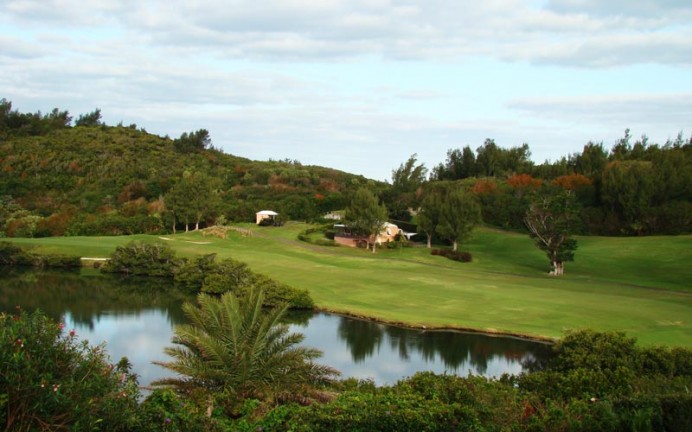
‘Macdonald placed the two hundred yard long fifth fairway on the other side of Mangrove Lake from the tee. Set on a diagonal, the unendingly fascinating question posed is ‘ how much do I dare carry?'”

The right to left tilt of the fairway is more pronounced the farther one is from the lake. Thus, one of the hole’s risk/reward dilemmas is to hug the lake off the tee for the sake of a better stance and angle into the green.
Sixth hole, 360 yards, Brow; Charles Blair Macdonald studied at St. Andrews and his love of The Old Course is evident in the number of holes whose design merits he replicated, including the Eden, Road, and Long (all three are found there at Mid Ocean Golf Club). Macdonald appreciated the land contours of The Old Course and how they were employed within the holes to frustrate/infuriate golfers. He learned his lesson well and that is seen here at the sixth. Relative to the landforms at St. Andrews, the ones here are more pronounced as the landing area and green are both on brows of hills, hence the hole’s name. The typical Mid Ocean golfer is more than happy to hit his approach shot from the thirty-five yard wide brow of the first hill as it leaves him but a short iron into the green. The tiger golfer with today’s equipment may elect to chase his tee ball over the first hill and leave him but a sixty yard flick to the uphill green. However, Charles Blair Macdonald‘s study of The Old Course pays off again as the first third of the green slopes away from the golfer. A primary reason for The Old Course remaining the complete challenge that it is decade after decade is to be found in the number of its greens that (partially at least) slope away from the player. Here is another example.
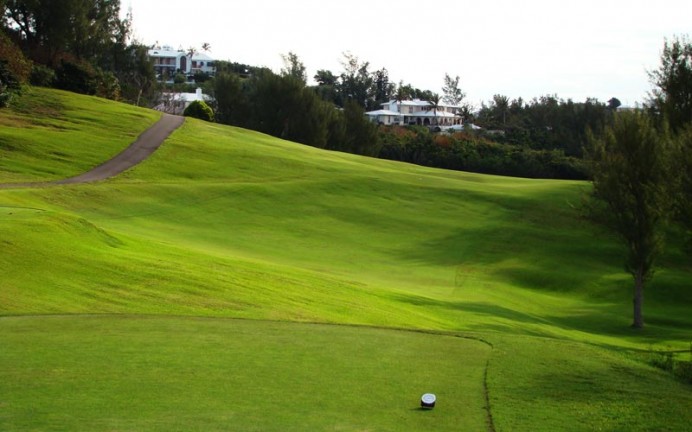
Finding the crest of the hill should suffice – or does the golfer want to gain a turbo kick by carrying his tee ball beyond it? The ugly scar cart path was not present in Macdonald’s day.
Seventh hole, 165 yards, Short; Thirty-five yards have been added to this hole since Macdonald‘s day but as it plays sharply downhill, it frequently plays to the same club as in the days of hickory, which is to say between a mashie-niblick and niblick (or seven to nine iron). In recent years, the fronting water hazards have been expanded to wrap around the front right and in particular front left and side of the green. Macdonald didn’t frequently employ water near his greens as it is a non-recoverable (and therefore boring unless used sparingly) hazard. The elevated tees and water hazards when coupled with the swirling winds that come up this valley create uncertainty in the golfer’s mind. When in doubt, and regardless of the day’s hole location, the wise play is to the back right center of the green.
Eighth hole, 350 yards, Valley; In the days of hickory clubs, no one thought about driving either the fourth or eighth greens. Ironically, the onslaught of technology may have made both these holes even better than they were in Macdonald‘s day as now the tiger golfer has the option in favorable wind conditions to have a go. Similar to the fourth, this green is well defended but unlike the one at the fourth perched a top a hill, this green complex is entirely manufactured. Given the paucity of dirt available, one assumes that Raynor and Banks dredged up the dirt from the lake at the nearby ninth when they created this built up green for Macdonald.
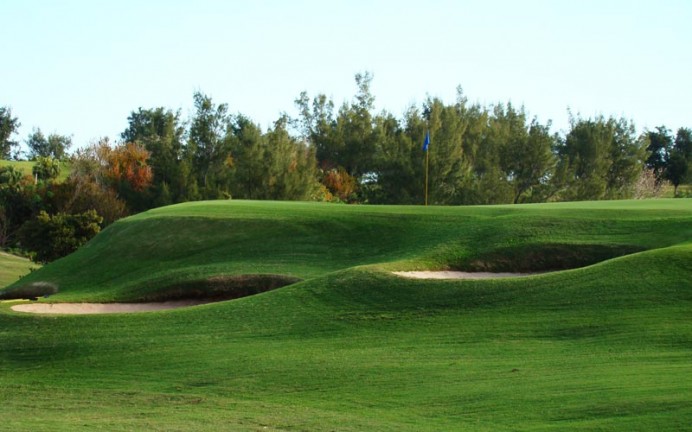
Typical for Macdonald and of good architecture in general, the shorter the hole, the more well fortified the green complex. No reason to flirt with going straight at the left hole location as seen above; let the green contours from the right funnel the approach shot close.
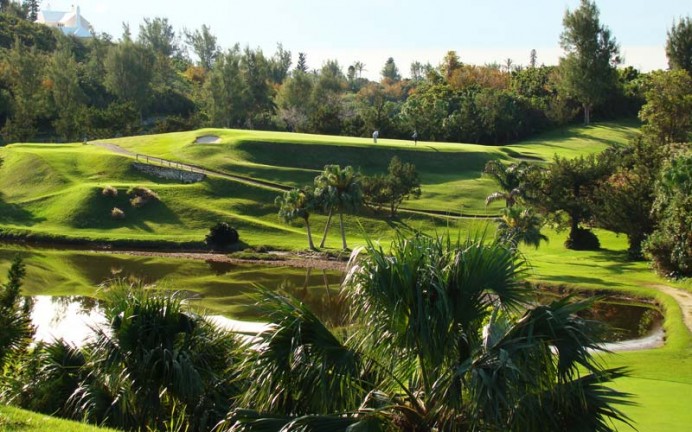
This view from the ninth toward the back of the eighth green highlights how much dirt was required by Raynor and Banks to create the fill pad that is now the eighth green complex.
Ninth hole, 405 yards, Sound; Tom Doak has been the consulting architect at Mid Ocean for the past eight years. A long time admirer of the course since first seeing it in 1988, his primary advice to the Club has been to bring their greens to current standards. From 2003 through 2005, Doak oversaw the replacement of the old common Bermuda greens with TifEagle. The increased firmness coupled with more pace allow such boldly contoured putting surfaces as the ones at the fifth, eighth, ninth and seventeenth to once again function properly. The golfer is now free to use the interior contours to funnel his approach shots to certain back hole locations as Macdonald intended. Here at the ninth green and tenth tee, the golfer is at the high point of the inland holes and Doak is a huge fan of the topography found in this stretch. Indeed, Doak states that, ‘Apart from his one-off piece of property at National Golf Links of America, Mid Ocean may well be the second finest site that Macdonald was ever given to work.’ Even with the help of topo maps, routing the course must have been a very slow process due to the thick semi-tropical vegetation that was found throughout the inland holes. Today’s ninth, for instance, plays through what was once a dense cedar forest. Though the same length, the ninth and tenth play totally different from one another yet at an equally high standard, a sterling example of how Macdonald used the topography to yield two distinctive holes.
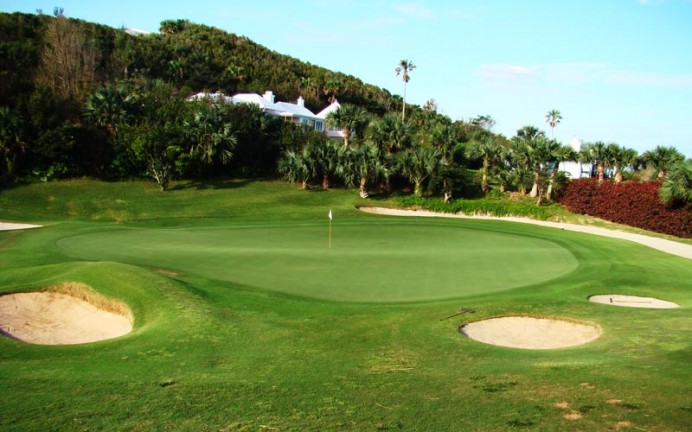
The contours found within the greens at Mid Ocean deserve more recognition, especially since Doak helped the Club reseed their greens with TifEagle. As seen from the tenth tee, a humpback ridge divides the ninth green into a lower left and upper right section.
Tenth hole, 405 yards, Mercer Hill; In stark contrast with the ninth, the tenth cascades downhill. A mirror Road Hole, this demanding hole plays along the spine of the hill. To the left is impenetrable brush and to the right the hole falls away into the valley of the ninth. The quintessential Road Hole green complex greets the golfer: the angled green best accepts approach shots played from the side of the fairway closest to the most severe trouble. Shots played from the right must contend with the central bunker that eats into the middle of the angled green. The long, deep bunker around the back of the green is meant to replicate the terrors of the road at its name-sake hole in St. Andrews. Though it measures nearly seventy yards shorter than the famous seventeenth, the prevailing wind quarters against the golfer from the right, making this hole quite the beast.
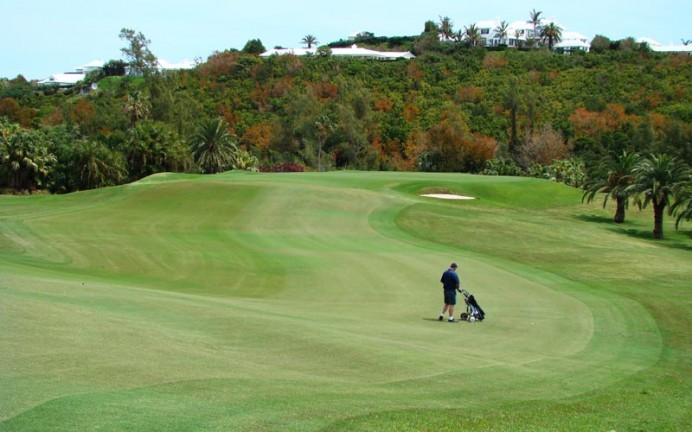
The single fronting Road bunker does an admirable job of guarding the green. The fact that the landing area pushes tee balls to the right makes this bunker
Twelfth hole, 435 yards, Hillside; As its name suggests, the drive is played over the side of a hill. The view from the tee is neither illuminating nor encouraging as only a glimpse of the right edge of the fairway is afforded. Sadly, no living architect would build this hole today “ they might shave the hill a bit to afford better optics or perhaps bring even more drastic earthmoving to bear. Yet, one wonders why? The course leaves the shoreline at the fourth tee and doesn’t return until the eighteenth tee. Apart from the course’s idyllic setting, its lasting appeal rests in how Macdonald used the topography on its interior holes to maximum effect. Without doubt, the course is all the better for having such a distinctive hole among its mix and many members consider this the toughest par on the course.
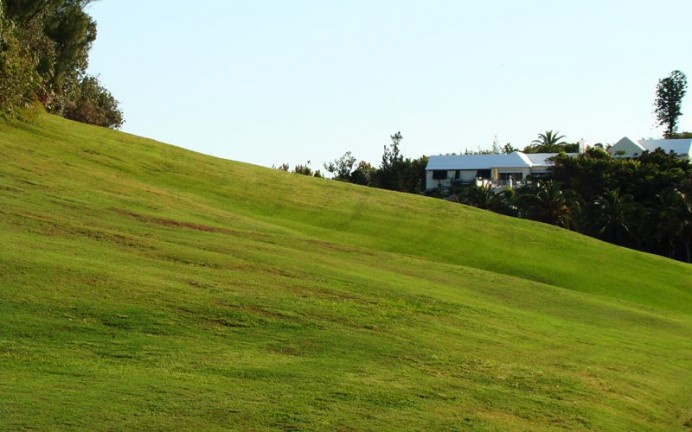
The daunting view from the twelfth tee. By leaving the hillside untouched, Macdonald created a unique hole that sticks in the golfer’s mind while at the same time reinforcing the site’s interesting topography.
Thirteenth, 240 yards, Biarritz; Mid Ocean possesses the classic quartet of Macdonald/Raynor short holes: the Eden, Short, Redan and Biarritz. In Macdonald’s mind, these four one shot holes constituted the ideal in part because they play four distinct distances and require four different type shots. Interestingly enough, this desire to fulfill Macdonald’s intent has led the Club for the past fifty years to only maintain the back half of this original full Biarritz green as putting surface. Labor and maintenance of a 12,000 plus square foot green isn’t the compelling reason they elect to do so; rather it is the notion of a forward hole location and the subsequent potential shortening of this hole’s playing length by thirty to forty yards that deters them. Such a forward hole location would likely give the golfer on this downhill one shotter too similar a club to either the Eden or Redan hole. As it plays today, the golfer is asked to hit a long iron and that is plenty fine with the Club and one thinks Macdonald too if he were still here.
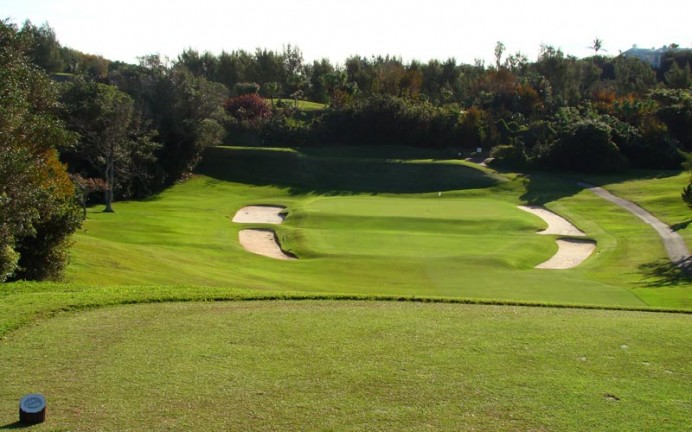
Only the back half of this Biarritz green complex is maintained as putting surface; thus, the hole is always guaranteed to play long.
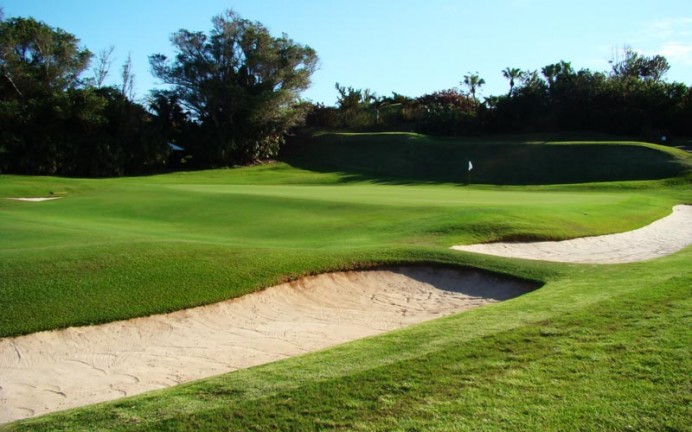
At ground level, the swale that fronts the putting surface is evident. Given the angle of descent from the tee, getting a tee ball to release through the swale and onto the green is tough; better to fly the tee ball directly onto the putting surface.
Fourteenth hole, 355 yards, Leven; Macdonald borrowed a design concept from the original seventh hole at Leven Golf Club in Scotland when he built the famous seventeenth at National Golf Links of America, long considered one of the best medium length par four holes in American golf. Similarly here, Macdonald created an arresting bunker complex down the left of the fairway and another stunning one at the green’s right front. The time-honored challenge is evident: flirt with the bunkers and drive the ball long left to be rewarded with a clear view of the green. As one shies away to the right, he is forced to accept a forced carry over the deep greenside bunker.
Fifteenth hole, 505 yards, Punchbowl; Macdonald was an imposing figure of a man and the boldness of his personality shines through here. The fourteenth and fifteenth once shared a fairway, separated only by the extensive bunker complex down the Leven hole. They were also both par fours and in Macdonald’s quest for providing variety, he devised a punchbowl complex for this hole by building a pronounced fifteen foot hump in front of the green. Unlike the Leven hole where the golfer contends with a ferocious fronting bunker, here the front is bunkerless with the golfer needing just to carry the hump to have his ball tumble down onto the putting surface. Robert Trent Jones in 1953 extended the tee back 85 yards to create today’s par five for two reasons. First, balanced nines featuring two par fives, two par threes, and five par fours was in vogue. Secondly, and more importantly, the public through way that cuts seventy-five yards in front of the green was quite a bit busier than in Macdonald’s day. By stretching the hole, play became safer for all concerned.

Whether it is a short iron for a third shot or a three wood in two, hitting into a Punchbowl is always an enticing prospect.
Sixteenth hole, 375 yards; Lookout; As Macdonald notes in Scotland’s Gift, ‘One great difficulty was to build the course so that there wouldn’t be too much mountain climbing. After much study, we succeeded in doing this, so that to-day there is only one real climb, that is, at the sixteenth hole.’ The climb to which Macdonald referred occurs on the tee shot, which must scale an abrupt thirty foot embankment one hundred and fifty yards from the tee. This shot must have been especially daunting in the days of hickory golf. A good, straight strike from the tee is paramount, especially as there is a natural twenty foot depression found for 200 hundreds to 230 yards from the tee. The green is the second highest point on the course, just barely below that of the first green. As such, this exposed green is one of the toughest targets to find on a consistent basis. Upon seeing the hole’s modest length, the first time visitor may have high hopes for carding a good score here; the members know better.
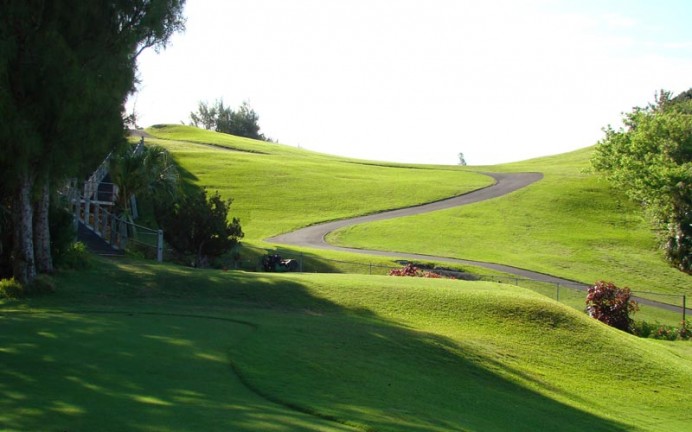
Macdonald had the holes attack the landforms in every possible manner. Here at the sixteenth tee, the tee ball must climb up and over the side of the valley wall. As at the sixth, one needs to do his best to ignore the poorly placed cart path.
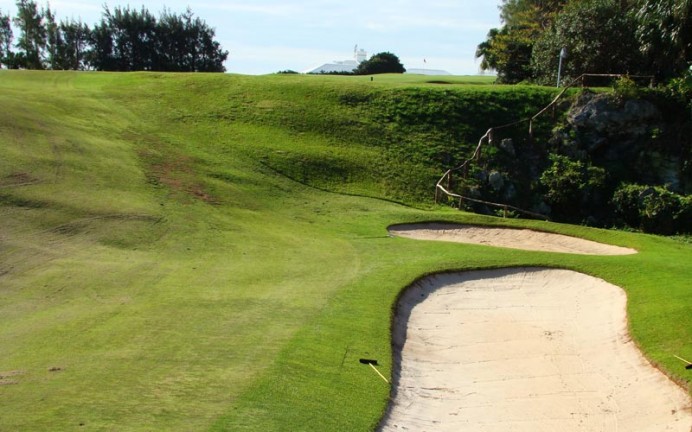
Once on top, though, the golfer needs to hope that this deep depression 150 yards from the sixteenth green hasn’t gathered in his tee ball. If so, his approach shot is blind.
Seventeenth hole, 205 yards, Redan; For many traditionalists, the decade of the 1920s represents the pinnacle in golf course architecture. Coming as it did so early in the decade, there still wasn’t a lot of precedence in North America from which an architect could draw upon for inspiration. For instance, at the seventeenth, would a lesser architect than Macdonald have seized upon the right to left slope of the land as the perfect invitation to build a Redan while at the same time gracefully transporting the golfer to the cliff for a rousing Home hole? Perhaps not and fortunately the point is a moot one. A majority of Macdonald/Raynor designs feature the Redan hole in the first nine. Coming as the penultimate hole, this one falls at the latest stage in the round of the approximately twenty Redans that they built. Frequently played against the breeze, a hooded long iron or wood that just carries the short bunkers, takes the slope and runs onto the green is one of immense satisfaction. Its outstanding playing characteristics coupled with the hole’s setting help make this one of the two or three finest Redans in the Macdonald/Raynor family.
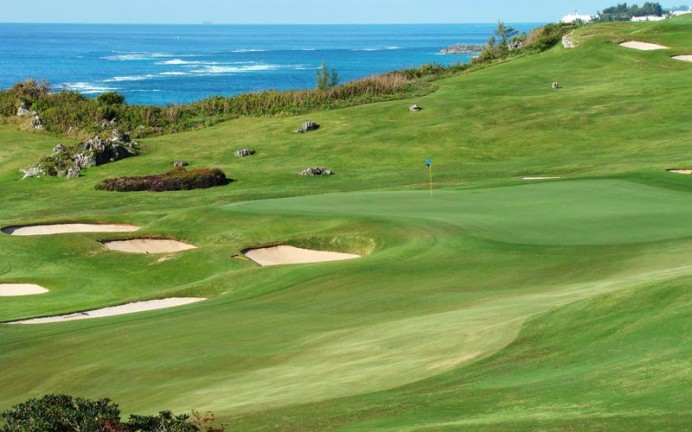
The elevated seventeenth tee allows the golfer the thrill of watching his ball bounce along the ground as it takes the right to left slope. Given the keenness of the new TifEagle greens, the golfer needs to take care that his tee ball doesn’t run too far and into one of the three deep greenside bunkers.
Eighteenth hole, 420 yards, Home; Hugging the cliff line, the Home hole makes for an entirely satisfactory closing for this island course. The views off the back tee markers are every bit the equal of those from the eighteenth tee at Pebble Beach. The green, with its false front and bold contours is one of the finest on the course.
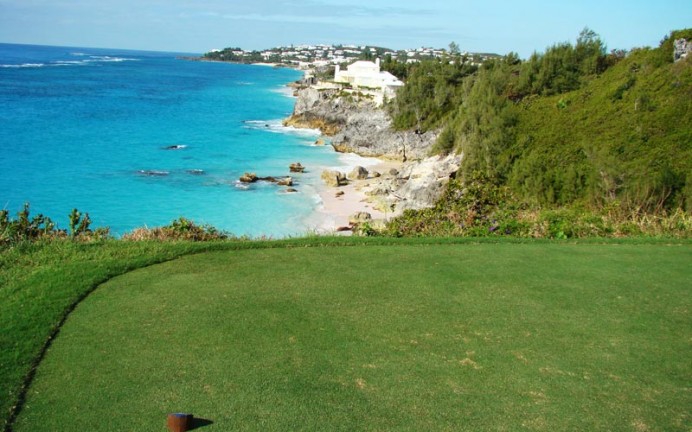
Whichever direction one turns on the eighteenth tee, one is vividly reminded of the course’s island setting. This view off the back marker is in a westerly direction whereas this view…
The creation of Mid Ocean was originally driven by the desire of the Furness Withy Steamship Company to stimulate shipping and cruise line business to this island five hundred miles east of North Carolina. After World War II, most of its vessels were in poor repair having been commandeered for the war effort. In addition, the notion of tourism was but a dim thought in the aftermath of the war horrors. Consequently, Furness Withy sought to divest itself of this property. A group led by Sir Harry D. Butterfield purchased the entity and the Mid Ocean Club of today was formed in 1951. In 1953, the board called in Robert Trent Jones to improve upon the course that lay fallow during the war years. His contributions were largely constrained to the creation of many of today’s back tee boxes and the course grew in length from 6,121 yards to nearly 6,600. He did not move a single green complex, a clear tribute to the skill of Macdonald’s work. Certain bunkers were removed such as a long thin one on the outside of the Cape hole. Today’s board, appreciative of the course’s classical roots, is considering restoring such bunkers.
Mid Ocean has hosted many famous gatherings, one of which was a 1953 summit meeting after World War II between the leaders of England, France and the United States. In attendance was Winston Churchill. Though a famous non-golfer, one can imagine Churchill’s utterance that ‘I am a man of simple tastes, easily satisfied with the best’ as being applicable to Macdonald’s work at Mid Ocean.

The Union Jack, Stars and Stripes, and Bermuda flags proudly fly along the eighteenth fairway.
Recommended Reading: Mid Ocean Club, Bermuda – A Portfolio of Fine Art Prints from the
Original Paintings by Kenneth Reed FRSA, written by Alan W. Dunch,
J.P. & Keith Mackie, available in the golf shop.
The End


